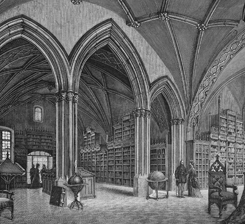ALL ISSUES

CREDITS, p. 2
ARTICLES
Libraries in Poland. As of 2012, p. 6–132
The report includes a discussion of the major networks /types of libraries in Poland, their status and activities in 2012. Where it was possible the analysis includes data on the operation of libraries in the perspective of the last decade, which captures the changes taking place within them, and an indication of the main problems with which they are dealing. The analysis covered the local libraries: public, pedagogical and school as well as academic libraries (including universities public and private libraries), specialized libraries, fiction/specialized libraries, libraries of “inte” centres, libraries of scientific societies, prison libraries, and church libraries including parish ones.
The report consists of two parts: a descriptive part containing data according to a specific layout for individual networks of libraries, and a quantitative part consisting of selected effectiveness indicators for these libraries.
The study used data collected by the Central Statistical Office of Poland for the part concerning communal libraries (public and pedagogical), scientific libraries, specialized libraries, fiction/specialized libraries, scientific societies and libraries of “inte” centers, and that collected by the Educational Information System in the section pertaining to school libraries. The situation of the other types of libraries is presented on the basis of reports and research results.
The scope of the collected data includes the following issues: the legal basis and organization of libraries belonging to a specific network, the number and profile of libraries, the policies, sources and scale of financing. The size and structure of the collections, their use outside versus the use inside of the library, number of readers (or users if they are registered), library computerization, e-services, library availability for special user groups, library staff and their educational background.
This report is a first attempt of this scale to present libraries in Poland in every aspect of their activities.The Oldest Extant Prose Text in the Polish language.The Phenomenon of the Holy Cross Sermons, p. 133–159
The manuscript of the Holy Cross Sermons consists of 18 parchment strips, which are fragments of 4 folios in octavo format (13 strips make up a dual folio, and 5 form the lower parts of two other folios). These strips are probably remnants of a more extensive manuscript. This monument was discovered in 1890 by Aleksander Brückner in a Latin codex in the Imperial Public Library in St. Petersburg, bearing the number Lat.I.Q.281. It had come to the St. Petersburg manuscript collections from the Library of the University of Warsaw, expropriated by the Russians after the November Uprising in 1831. The Codex (destroyed during the last war) came from the library of the Benedictine monastery of the Holy Cross at Łysa Góra (Bald Mountain). It was made in the 1st half of the 15th century, and during the binding, as individual contributions were sewn together, the manuscript of the Polish sermons was cut into strips and used as supporting pieces. Before coming to Łysa Góra, the Codex in which the sermons were found was lying near the hermitage of St. Mary Magdalene at Leżajsk, where it belonged to the Benedictine monks of the Holy Cross. This monument contains a set of six sermons, one of which survived in its entirety, and five in irregular sections. These are sermons for the following days: St. Michael (only the end of the sermon is preserved), St. Catherine (all), St. Nicholas (the beginning), the Nativity (the ending), Epiphany (the beginning and end) and the Purification of the Blessed Virgin Mary (the beginning). The sermons are clearly intellectual in style. They differ from one another in structure. They are written in exquisite, artistic prose, rhythmic and rhyming. The unknown author wrote them in a style used in Latin literature of the twelfth and thirteenth centuries that stood out through parallelisms of syntax, rhyme and rhythm (ie. Ars dictaminis). So far, no Latin models have been found for the Holy Cross Sermons.
The Polish manuscript of the sermons is probably from the early fourteenth century. It is, however, a copy, and perhaps a copy of a copy, the original being likely from the late thirteenth or early fourteenth century. The text of Sermons was written in Gothic minuscule with numerous acute abbreviations. Such a strongly developed system of abbreviation has not previously been seen in any medieval monument of Polish literature (as well as Czech).
The system used in the abbreviations is thoughtful and closely modeled on Latin forms. This proves the long practice of writing in Polish and the existence of the scriptorium, where many other manuscripts in the Polish language were probably created for the purposes of other collections, now irretrievably lost. The text of the Sermons contains many very archaic linguistic forms and compound words, in which it definitely differs from all subsequent historical forms of the Polish language. It still uses orthography found in diplomas and documents from before the fourteenth century. The Holy Cross Sermons stand thus at the beginning of the history of Polish literature, as this masterpiece is the first continuous independent Polish text in which the Polish language, previously existing in oral forms, takes the form of writing. They are also proof of the high level of Polish written culture before the middle of the fourteenth century. The Holy Cross Sermons belong to the oldest, most archaic layers of Polish literature. They indicate that before the middle of the fourteenth century, works in the Polish language were of an elite character. There was then in Poland an intellectual milieu interested in cultivating a literature in the national language and of a high artistic level. From the middle of the fourteenth century, literary works in the Polish language became a much more popular focus of collections.Calvinist Censorship in the Light of the Acts of the Lesser Poland Synods, p. 160–166
On the basis of remaining published and manuscript records of the Protestant synods and statements by members of the congregations, the present paper shows how the synods passed resolutions and opinions on the control of printed works before printing operations took place. Examples of such censorship, and of proceedings in cases where it was not used, especially in the case of Arian books, are presented.
Remuneration for Works Dedicated or Donated to the City Council of Gdańsk in the 17th centur, p. 167-179
In the 16th century the custom of putting dedications in printed books spread widely. They quickly became a conventional form of writing, serving as an advertisement and decoration, and often stressing the bond between the author and his patron. Apart from literary aspects and gestures of gratitude, dedications normally were not selfless. Their aim was often to elicit a particular profit - for example compensation for incurred costs or time - as a token of the addressee’s appreciation. The problem lies in determining the actual amount of this appreciation. The account book of Gdańsk, the biggest Polish city of the 16th and 17th centuries, comes to our aid. In books of the city’s budget expenses, we can find notes on funds spent on dedications written for the city council, the mayor, or the whole city. Despite the brevity of entries, we can easily make a correlation between tenths of dated notes on the amount of payments, and particular publications and their authors. In the lists of those awarded we can find the names of famous as well as completely unknown people from Gdańsk, Poland, and abroad.
This publication is the result of an introductory query into several volumes of the city’s accountancy. Materials from Gdańsk’s municipal treasury, without any major deficiency, are well preserved from the end of the 17th century to the Second Partition of Poland, when Gdańsk was seized by Prussia. It is a fact that more detailed studies of accountancy mentions would result in a deeper understanding of extra-literary aspects of the custom of dedications in Gdańsk itself, and in the Poland of that era.The Antidotarius animae of Nicolaus de Saliceto as Published by Kaspar Hochfeder, p. 180–193
Antidotarius animae by Nicolaus de Saliceto was one of the most popular prayer books printed in the 15th century. Kaspar Hochfeder was one of the printers who published that text most often. Three of his editions bear no date or address. Detailed analysis of a few copies of these editions, also in the context of other copies, enables us to present a new way of dating them, defining the sequence in which they appeared and the place where they were printed.
The Collectio Autographorum of the Imperial Public Library. Its contents and history in St. Petersburg and Warsaw, p. 194-213
The article presents the history and content of the so-called Collectio Autographorum that was created from part of the manuscripts of the Imperial Public Library in the 1840s. They entered its constituent entities from different provenances, fragments of manuscripts from the collections of the Zaluski Library, a substantial part from the collection of Peter Dubrowski, and from other collections of the IPL gathered in the first period of its existence. In the 1920s, a large part of the Collectio Autographorum was returned to the re-established Polish State and furnished the National Library in Warsaw. Most of this portion was burnt in 1944.The Deacidification of Library Materials at the National Library of Poland, p. 214–224
In the mid-19th century, mechanical pulp paper became the fundamental medium for information storage, enabling substantial access to it. Unfortunately, over the decades the deterioration of its structure began to be visible even to the eye, which led to intense research in chemistry in the second half of the 20th century aimed at determining the durability of this material. The question of paper and cellulose degradation became an important topic for librarians, archivists, and materials science.
The paper presents the developing interest in this issue in the Polish scientific and librarian community, as well as the multi-faceted and effective consequences of actions taken in response. This article presents a summary of the eight-year period of the de-acidification of paper conducted in the National Library of Poland, starting in 2007-2008.Reading/writing in ICT. Habitual alliances and individual style, p. 225–239
This article discusses the notion of strategies users/readers employ for reading/writing in the environment of information and communication technologies.
By triangulating video recordings of particular actions undertaken by participants with semi-structured interviews concerning their habits of working with information, it proposes understanding reading/writing in ICT as managing habitual alliances formed within and outside the environment of ICT.
REVIEWS
An Important Milestone in Research on the Manuscripts from the Załuski Library and their Documentation: O. Bleskina, N. Elagina (eds.), The Inventory of Manuscripts from the Załuski Library in the Imperial Public Library, Warsaw, 2013, p. 242–247

